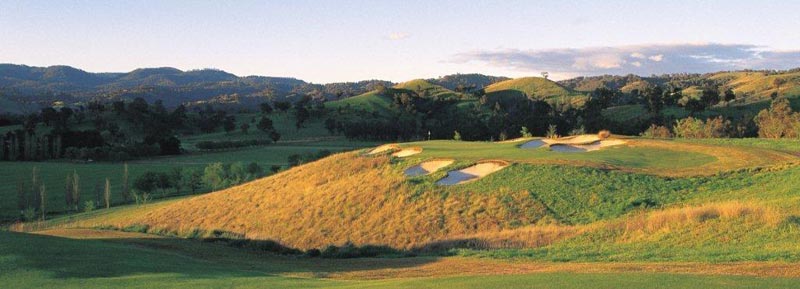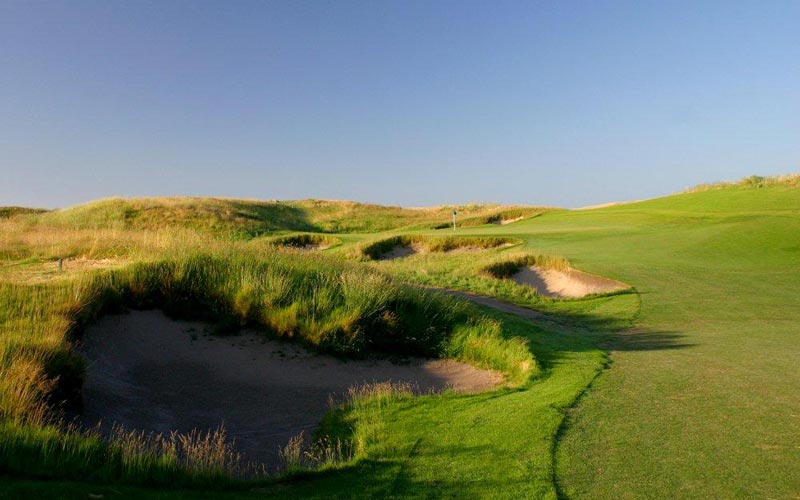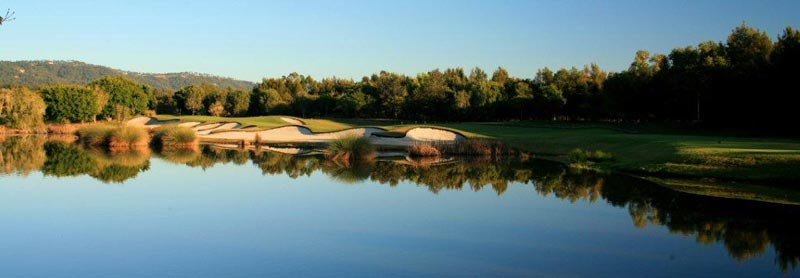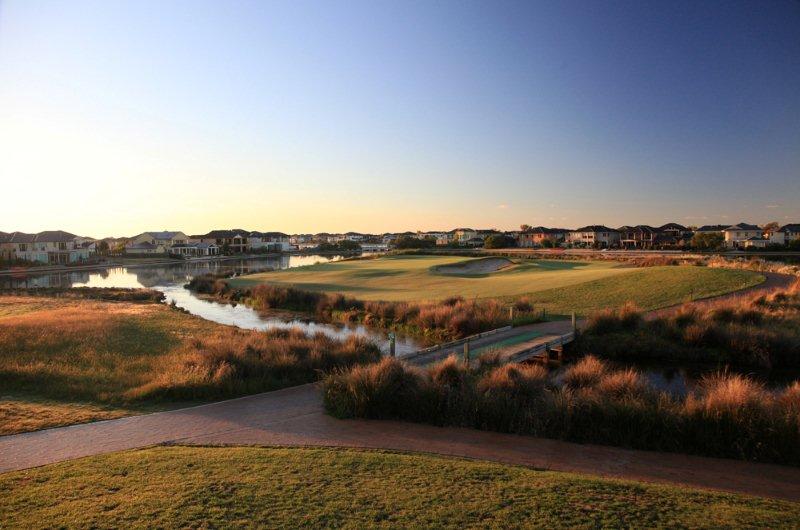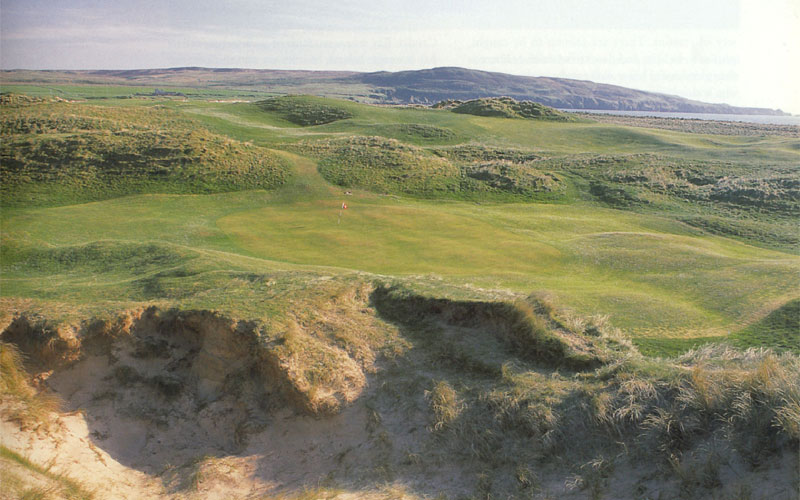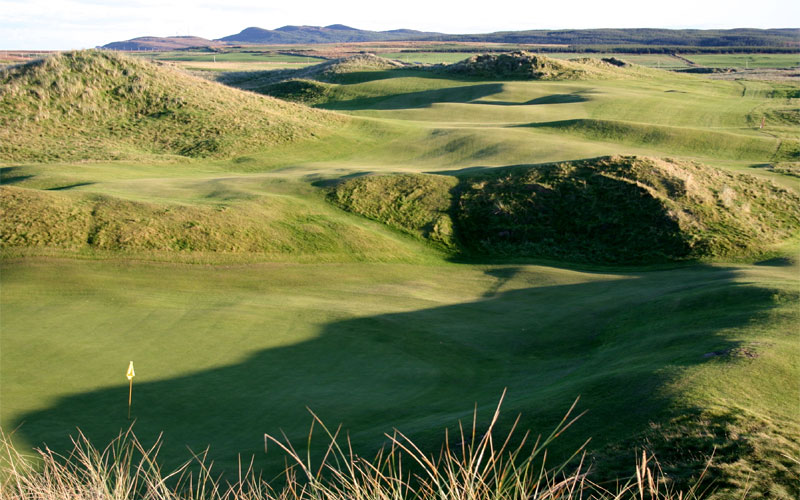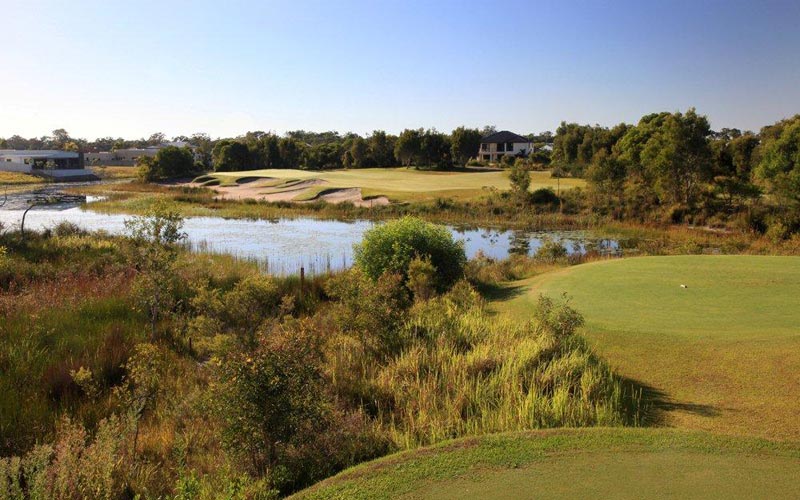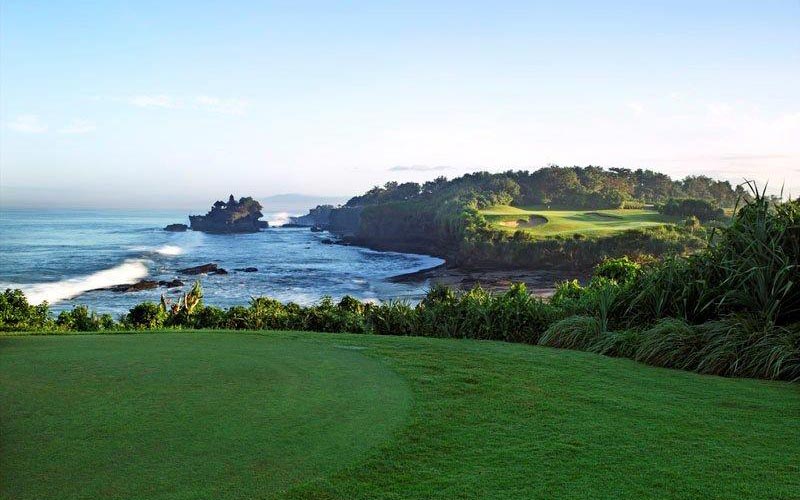Feature Interview with Bob Harrison
July, 2010
1. What are you doing right now?
Since splitting from Greg Norman Design in October, 2009, I’ve set up my own company – Harrison Golf – to continue golf course design in my own right. It’s a great passion for me, as it is for many in the industry, and I want to keep doing it til I drop.
Getting the new venture under way has been a real shock for someone who previously was totally illiterate around computers. We now have most of it done, including the brochure and website (www.harrisongolf.com.au).
With regard to new projects, there is a number of irons in the fire, and it will be interesting to see how many come to fruition. I expect that a few will happen quite quickly, and I’m keen to get ‘on board’ again. I also hope to write more about golf, and possibly find the time to rediscover oil painting.
2. Unlike most architects around the world, your proximity to the Sandbelt courses around Melbourne has given you unlimited access to studying them. Have they influenced your design philosophy in any way?
When I was at university I made only one trip to the Sandbelt with some mates before I started in golf course design. So, in the early days, it wasn’t a case of having ‘lived and breathed’ the Sandbelt. But the principles I believed in from the beginning had a lot in common with the Sandbelt: fast, hard surfaces; an emphasis on delicate chipping from perfect lies rather than 3 to 4 inches of ‘cabbage’; the dramatic appearance and patterns of bunkers; and the contrast and harmony between the highly-groomed playing areas and adjacent areas of wilderness. In this regard I always think of the 5th hole on Royal Melbourne’s West Course, with the wilderness blending into the outer edges of the greenside bunkers.
Later on I became a regular visitor to the Sandbelt, and I’m sure that the good qualities of these courses rubbed off on what I was doing. I can remember my first experience with Royal Melbourne’s greens. In those days they were planted with Suttons Mix, and they were renovated periodically by stripping the sod, removing the thatch, and then replacing it. The resulting appearance was mottled – but that didn’t matter. And I was most struck by the brownish appearance of the surface if you looked straight down at it. There was just enough grass to hold the surfaces together. But they were remarkably true and quick.
These days the nearby Mornington Peninsula has quality golf courses as well. The combination of these two areas is powerful for good golf, but I think we’d still benefit from one or two more on the Peninsula.
3. Almost all golf architects claim to be devotees of MacKenzie, some outrageously so. Do you see yourself in the same light?
It’s true that everybody in the business claims some attachment to MacKenzie, and it’s true that many of these claims are truly outrageous. I don’t see myself in the ‘outrageous light’. I’d been working on my first course for a number of years before becoming aware of the MacKenzie tradition. I was interested in landscape painting, and I wanted to make sure from the start that the holes and their components (particularly bunkers) were attractive to look at. I was also fanatical that all of the shapes produced on the course should appear to be natural and flow together continuously over broad areas, rather than occurring in isolation. It was common at the time to see flattish fairways lined by a continuous run of ‘moguls’ in the roughs – and this unnatural shape never appealed.
So I think many of my ideas were intuitively the same as MacKenzie’s. But I wasn’t aware of this until later. By the way, I believe that MacKenzie’s results on the ground depended heavily on who was ‘doing the doing’ course by course. If he got Morcom and Russell he got a great result. In other places he got a lesser result. But he did have good design principles. However, he got lucky because a few of these related to play but, by chance, translated to dramatic appearance as well. It’s interesting that he COULDN’T DRAW.
In the interview in April 2000 I suggested that many golf architects do not really understand the basics of shape and harmony, and would benefit from a course at art school. I mentioned that there were 5 to 6 design principles which would really help, and a number of people subsequently asked me about these. A couple of them can be briefly outlined as follows:
• You can’t afford to have too many horizontal lines or shapes, particularly if the vertical dimension is small and if the result is to separate greensites, for example, from the rest of the picture.
• Shapes look better in the direct line of sight rather than being spread in a horizontal sense. By fluke, this more-or-less coincides with one of MacKenzie’s ambitions to have the hazards “where shots would normally goâ€, and to make the holes interesting by forcing golfers to choose.
• Diagonal shapes are attractive, and are improved if there is some contrast in the vertical component of different sections of the shape.
Over the years Vince Flemming and I have spent countless hours setting out shapes on the ground before constructing bunkers – in order to make them appealing to look at. We used a variety of methods (including lengths of heavy white hose, lime or marker paint). All with the objective of going back some distance and being able to picture what certain lines would look like once the work was done – and normally with several iterations before we were satisfied. I’m a strong believer that you have to put a lot of effort into design to get a good result.
4. Without giving away trade secrets, what design innovation(s) have you brought to golf course architecture?
I’m not sure that you’d describe them as innovations, but it’s probably true that there are trademarks. I’ve already mentioned the emphasis I place on the shapes of individual bunkers and groups of bunkers, and on creating shapes which fit naturally into the landscape. Over the years this has often meant that my greensites start 50 to 70 yards short of the green, rather than at the green surface.
I’ve always objected to the modern trend against uphill par 3’s and downward-sloping greens. In the right place I think both of these concepts are not only OK, but advantageous. And there are uphill par 3’s on National Moonah, Ellerston, Nirwana Bali, and The Grand for example. And downward-sloping greens can be fun to play and dictate the way in which shots should be played – as they do most noticeably on the greens at St Andrews, where the best angle of approach is often determined by the downwards slopes in sections of the greens.
In the early nineties in Bangkok I did introduce the idea of shoring up the faces of bunkers with vertical hardwood boards. The aim was to create a defined edge between bunker and grass which would be stable. Exposed boards would be dangerous, but in the hot Bangkok climate the grass would grow down the face of the boards and soften the impact of errant shots – while providing the dark margin to the bunker (and the consequent shadow) which helps make the MacKenzie style look attractive. I tried this idea at Tamworth in New South Wales, but with less success – particularly in the dormant winter months.
Another approach which might be a bit unusual is my ambition to create colour-coordinated landscapes on the courses. I’ve always thought that colours in the range light-blue through mauve to purple, possibly in conjunction with white, are the best choice for a course, combined with green leaves and green grass (parkland courses). So I would choose trees that promised these colours in profusion, and group them to get the best effect of combined colours.
I’m not alone in doing so, but I’ve often placed bunkers for no other reason than dramatic appearance – even if they lie 50 or 100 yards off a tee. This is not always popular, and lots of golfers argue that bunkers should never be placed where they perform no strategic function. But I think it can sometimes make a hole look fantastic and frightening, and therefore don’t apologise.
My friend Mike Clayton won’t like this, and some of the players in the 2001 Australian Open certainly didn’t, but I sometimes leave trees in fairways. The case in point was The Grand, and the holes in particular were the par 5 12th and the uphill par 4 13th. Apart from the fact that the trees helped make the 12th look dramatic, this hole would be nothing more than an open drive and a 4, 5 or 6 iron across a pond if you took them away. The trees force players to place their drives to the left, and then decide whether it is worth the risk of playing the ‘all or nothing’ shot through the narrow corridor and across the water to a small green.
One of the results I’m proudest of is the character achieved on the inland holes at Nirwana Bali by constructing large areas of rice terraces throughout the roughs. This was done to create the illusion that the course had been laid out through them, and to make the holes spectacular to look at and Balinese in flavour.
In the old days courses were built on suitable ground for golf. These days construction machinery and commercial imperative often mean that they are not. It’s been a very interesting exercise to draw design contours for the whole of a golf course site in a flood plain, where the average level of the completed course is lower than the original natural surface in order to allow adjacent residential areas to be constructed above the flood.
5. As you go out on your own having been with Norman Design for 22 years, what , if anything, will you do differently?
Much will stay the same because, by and large, I did much of the work.
Perhaps I’ll have a willingness to be a little less rational, and trust that golfers will accept the fun and the element of chance – particularly at landing areas. But there’s probably not much different about this. I won’t be extreme.
I think your ideas develop and change with time in any case, and I’ll probably place even more emphasis on ‘half holes’ if circumstances allow: short par 4’s that are occasionally driveable; short par 5’s with the balance of probability that a hole like 13 at Augusta has.
Perhaps also I’ll be a little less commercial. I don’t mean this in a stupid sense – there is always the need for a business to succeed – but I’ll probably have more flexibility in this regard.
6. You’ve worked with very good sites and very bad ones. How does your approach differ?
In this business you get all sorts of sites. Occasionally really good ones, and more often mediocre or even bad ones. At one extreme, the poor sites can be dead flat (perhaps even full of rock) and, at the other extreme, mountainous country that you would never suspect was suitable for golf. While my ambitions about all courses, whether on good sites or not, are fairly constant, the approach to the design differs significantly. On poor sites you often have to draw design contours, perhaps as tight as half-metre contours, over the entire project in order to prescribe an exciting and interesting surface for golf. This is also done to accurately determine volumes of earthworks, or volumes of flood storage, or whatever volumes the circumstances demand. While this drawing work can be done well, there will still be the need to refine the surfaces on the ground during construction. You have to spend considerable time on the site, but perhaps not to the same extent as would occur if the site was a beauty and had lots of natural features to take advantage of.
Moonah at The National was an example in this category, and required hundreds of hours of joyful site inspection to find the best and the most natural holes. Subsequent to this effort, the drawing exercise was nowhere near as involved as it would be on a really bad site. The Glades, Sanctuary Lakes and Pelican Waters are all examples of courses where every square metre was drawn on essentially flat sites. While both The Glades and Pelican Waters were flood-prone, the exercise at The Glades was particularly difficult in order to satisfy Council’s requirements for maintaining flood storage in the Nerang River.
The Nirwana Bali site was not strictly in either category. It was very beautiful but needed some manufacturing to reach a good result. At the beginning of the project it was almost entirely covered with rice fields. These were demolished, and the ground reshaped to reflect the surrounding shapes and to create good golf, before new rice fields were constructed as part of the broad area of rough.
So to succeed in this design business these days you have to have more versatility in some respects than the good designers did a century or so ago.
7. If you could change ONE rule in golf what would it be?
This question pops up all over the place these days, and a number of potential rule changes have been nominated, including:
i. You should be given a preferred lie or a free drop if your ball lands in a divot on the fairway. This would be hard to police and open to interpretation;
ii. You shouldn’t be responsible for your own mistakes in keeping score. The obvious example being Roberto De Vincenzo in the ’68 Masters.
iii. Caddies should be refrained from helping players line up putts and align their stances. It’s a bit sickening to watch this emerging practice on television.
However, given one choice, my favourite would be to reduce the number of clubs from 14 to about 8. I’ve had this idea for quite a while and I’m not alone. And it was interesting at the recent Golf Architects Forum in St Andrews that it was nominated as one of the best ways to improve golf. However, it’s likely to be a pipe dream, and is most unlikely to gain any support from lobby groups, including the manufacturers. If the number of clubs is reduced, golf bags might become smaller and lighter, and a potentially great result might be that more golfers would choose to walk.
Rules aside, I’d also like to change at least one aspect of the culture of golf and would certainly vote for less stroke rounds. For many years I played with 2 friends every Saturday at The Australian, and we would cancel on any occasion when the event was ‘Stroke’ (Medal). It’s interesting to read Bernard Darwin’s accounts of the culture of golf when Matchplay was the main form of the game. Perhaps that will never come again, but let’s have more of it, more Stableford, more Ambrose, and more of anything except Stroke.
Lastly, on a less serious note, I’d like to revise the nature of golf to provide that the highest score wins. That would suit me fine.
8. Are the best golf courses located by the ocean? Why?
Historically, yes. But it’s an interesting conversation if we’re talking about new golf courses by the ocean, either now or in the future. It’s my understanding that in most parts of the world these days there’s a moratorium on building golf course anywhere close to the ocean. Which means that you’d have to stay well back from the frontal dune even if you get the very unlikely approval to touch any dunes. This is a really sad situation and often follows from green groups and others arguing that golf denies the general public access to the dunes.
A year or two back I was standing on one of the biggest dunes at Enniscrone and pondering this very question, because the chances of anybody other than the fittest athlete being able to scramble up and down steep dunes through waist-high tussocks, and with the constant risk of deadly snakes (at least in some parts of the world) are almost zero. Golf, on the other hand, opens up the dune-scape to a potentially large number of people, even though they have the audacity to be golfers. They’re still people. And golf would play some part in stabilising the overall landscape and maintaining a much higher proportion of dunes than there is of grass.
To answer the broader question, I agree that the best courses are located by the ocean. There’s nothing to beat the feel under your feet of the firm, crisp, links turf that is so often written about. Many of these courses are beautiful because of their interaction with the ocean, and this makes the journey even more pleasant. Despite this interaction, very few of these courses have any holes with water bodies on them (lakes, etc.). That’s also a plus. The firmness under foot, and the likelihood of wind, create much more variety in the shots required or possible. The courses are normally very walkable, and, with exceptions, are not closely integrated with housing developments.
I think one of the greatest of these advantages is the built-in facility to play low, running shots, which are often a great deal of fun and a test of skill.
9. What makes a great par 3?
What makes a great hole of any par? Drama, beauty, challenge, choice of shots, etc. Let’s take a few examples in the par 3 category, and these would include 16 at Cypress Point, 12 at Augusta, 5 at Royal Melbourne, and 6 at New South Wales.
They’ve certainly got drama in common – outstanding beauty in some cases. This is obviously what gives the 16th at Cypress Point its fame. But it’s also possible to argue that the outrageous tee shot required and the option of a par 4 approach to the left certainly gives this hole some merit. But the spectacular setting is perhaps the main reason for the hole’s popularity.
The 15th at Kingston Heath and the 7th at Royal Melbourne both belong to the sometimes unpopular category of ‘uphill par 3’. They’re also both quite short, and so is the 12th hole at Augusta, where the beauty is complemented by the wonderful tactical merit of a shallow, diagonal green with disaster lurking both long and short. It’s hard to imagine a hole like this having the same sort of appeal or strategic interest if you were hitting 3 irons or 4 irons to it – in which case the dimensions of the green and the locations of the hazards would be different, less interesting and less frightening.
So if used well, ‘short’ appears to be a favourable factor. This category also includes such notable holes as the 8th at Troon, the 7th at Pebble Beach, the 10th at Pine Valley, and others.
In the courses I’ve worked on, I’m particularly pleased with some of the uphill par 3’s. The 11th at Stonecutters Ridge in Sydney (construction work is nearing completion) is a short iron shot across a valley to a very elevated green which forms the horizon. The whole of the left hand ridge short of the green is covered with bunkers (see photograph) and the left hand pin spot will emerge above these bunkers into the sky. The right hand side of the hole is open and more user-friendly. The 13th at The Longyard in Tamworth, New South Wales, is a longer uphill par 3 where, once again, the green forms the horizon. While the 12th at Ellerston is markedly uphill, but the backdrop is the local hill country. On the other hand, the 15th at Ellerston is so severely downhill that it’s perhaps the least admirable hole on the course, even though it is very spectacular and demanding.
The 11th at Pelican Waters is a medium-length par 3 and slightly uphill, and was shaped to include an intermediate roll short of the green where 2 bunkers are located. These bunkers don’t serve any strategic purpose, but were included to complement the shapes at the greensite – and their removal would greatly weaken the appearance of the hole.
‘Short’ and ‘uphill’ are not the only categories for terrific par 3 holes – but they are ones which appeal particularly to me, partly because they’re not always well-regarded.
10. What are some common design deficiencies in modern architecture?
I think one of the common design deficiencies is a sort of ‘repetition’. There’s a sameness about a lot of modern courses. Given the boom in golf course production over the last quarter of a century, perhaps this is due to a lack of attention to the detail required to produce a good course, simply because the designers have a lot on, and haven’t got the time. Perhaps it’s also due to the likelihood that some in the design business don’t have the flair or the ability to design – even if they did put sufficient time and effort to it.
I think you see one example of this if you watch some of the US professional tournaments, where it seems necessary to surround each green with barbed-wire rough. This has a deadening effect on true golf and provides mainly one avenue of escape –the ubiquitous ‘flop’ shot. It’s sad, because it’s normally possible to design a greensite that requires inspired and skilful chipping without the need for so much rough. The shape of the green itself and the surrounds should allow that, even from a perfect lie, some pin spots are tough to get at while others might be more accessible – depending on where you miss.
One of the differences between courses in olden days and those in the more modern era is that earthmoving machinery has undoubtedly made it possible to construct courses on ground that previously wasn’t suitable for golf. In my interview with Ran 10 years ago I said that “In the hands of some designers this is a considerable benefit. In some hands it’s a disaster.†I think that many courses are shaped in a most unfortunate manner. There is too much distinction between shapes on fairways and the shapes in the roughs adjacent to them. An extreme example of this poor performance is where flattish fairways are flanked by a series of ‘igloos’ (supposed mounds) where the shapes appear to have no reasonable interaction. The objective – and the skill required – ought to be to produce continuous, undulating shape across adjacent holes to give the impression that the holes had been laid out on the shape, and not vice versa.
Golf courses might have become a little too rational, perhaps in response to criticism. This sometimes shows itself as a fear of taking chances. Landing areas become too much like runways, fairway bunkers are all graded to accommodate the length of shot to the green, no blindness is allowed anywhere, etc. Obviously this is not true in all cases, but it does appear to be quite common.
Lastly, I’m a strong believer that golf is meant to be played by walking – provided you are medically able to do so. I think it’s a sad fact of life that a lot of courses have been built in recent years which exclude walking completely. Some of the worst offenders are the more extreme residential courses, where greens and following tees are separated by enormous distances.
11. You’ve played a lot of golf in Britain – ignoring logistics which course would you like to see added to the rota?
I’m assuming that we stick with the rule that only links courses are candidates. So I suspect that you’re asking me which are my favourite links courses that currently aren’t on the rota. I’ll start by listing my top 5 courses in Britain. Not in order, these are: Royal St Georges; the Old Course; The Machrie; Royal County Down; and North Berwick. Silloth and Royal Aberdeen would be amongst the candidates for the next 5.
St Georges and the Old Course are on the rota, and, as much as I love North Berwick, I don’t think I’d choose it. That leaves Royal County Down and The Machrie. The former is the more rational candidate – it’s a wonderful course, it’s in great condition, and it is logistically sensible.
However, for emotional reasons, I’m going to pick The Machrie. It’s such a wild, undulating, irrational course in huge, magnificent sand dunes. I think it would be very interesting to see how the world’s best players would accommodate it – in particular, the types of shots they would choose to play. There are a number of punchbowl greens. Many of these are blind. And the approaches almost invariably cross undulating, pitching ground which suggests different shots in different circumstances – 6 iron approaches from 100 yards, for example.
Not that this is vitally important, but The Machrie is in magnificent condition despite its location in a wilderness. Given that it’s on the island of Islay, one of the homes of Scotch whisky, it also provides for those in need – if the course or the conditions become too cruel.
12. Do you see any significant changes in the future of golf course design and construction?
At least the short-term future looks a little difficult for golf course developments. The current downturn in economies and housing markets will obviously slow the number of new projects. The last period of golf course development is an interesting one because, by and large, courses have been built on land which is not naturally suitable for them – for commercial reasons relating to the opportunity-cost of attractive land, and for statutory reasons because the traditional home of golf courses – links land or anything close to the sea – is now a ‘no go’ zone for golf in most parts of the world. So golf courses have become more expensive to construct and to maintain. There was a boom in golf which is now suffering a bit of a downturn, and all of these factors make it less likely that golf projects as we’ve previously known them will continue at the same pace.
A possible outcome might be that 9 hole courses (or perhaps 12, but I hope not) might become gradually more popular and acceptable. Less land lost to development. Less construction cost. Less maintenance cost – all at a time when the market for golf perhaps doesn’t have 5 hours to allocate to the game.
All is not doom and gloom, however. It’s likely that golf courses will continue to be developed in conjunction with real estate in favourable circumstances. For example, I know of a project where the Authority granting the approval for a residential project did so only if the developer included a golf course – as a depository for the treated sewage effluent. It’s also common in recent times to find golf courses integrated with real estate where part of the project site is flood-prone and unavailable for houses as a consequence. The cost of the course is still substantial, but the loss of developable land might not be, and the amenity created by the golf takes on a more favourable aspect.
However, I think the most significant change is already under way. It’s the movement away from huge areas of turfgrass and the consequent volumes of water and chemicals required to sustain it. This subject came up at the recent International Golf Course Architects Forum in St Andrews, and everybody seems to agree that we have an obligation to be part of the general community movement towards more environmentally-sustainable development. Golf has to play its part as well. This is not a totally revolutionary idea – in some parts of the world it’s been under way for a while. But you’re going to see less area of maintained turfgrass and much more area of sustainable landscape, whether it be natural or manufactured. There’s also some discussion about changing the culture of golf to an extent and modifying golfers’ expectations of how golf courses are presented. For example, given that today’s drivers have massive heads and you use very long tees to accommodate them, do you really need the teeing ground to be intensely maintained at a height of a quarter of an inch?
Last but not least, it looks as if there’s going to be a move away from signature design and the hero worship which sometimes accompanies it. Commentators around the world have been agitating for this change for some time, and there’s some evidence of success already. One interesting, and perhaps surprising, factor which could play a strong part in this revolution is the attitude of the client group for golf courses in China. They appear to be far less oriented towards signature design, and it’s probably got something to do with signature fees. But it’s unusual in Asia. If this continues, design fees will probably become more sensible, and so too might the construction cost of courses. It’s also possible that this might lead to better golf courses in the future, particularly in Asia, and it might contribute to greater popularity for golf if handled properly.
13. As you look at the latest course rankings (choose whichever one you wish), what course would you recommend as Australia’s most underrated course?
If you’d asked this question 10 years ago there were 2 or 3 obvious answers – the most likely being Newcastle (Stockton) and Barwon Heads. But it’s interesting that both of these have risen from obscurity over the last 10 years. Newcastle is currently in Australia’s top 10, and Barwon Heads in the second 10. For a parallel in the USA, I remember that prior to my first visit many years back Cypress Point was ranked in the fifth 10 in America. And the new, long, overpowering and less sophisticated courses were in vogue at that time.
Back to Australia. I didn’t want to refer to one of my courses, but I’ll have to because I believe The Grand is the most underrated course. I’m not alone in this point of view, but it doesn’t appear to be the prevailing one. However, this might be the time to mention once again that rankings are a questionable commodity.
14. Of the courses you have designed, which one was the most “successful” and why? Which was the least understood?
Depends what you mean by “successfulâ€. I could argue for Sanctuary Lakes, partly because this was perhaps the worst natural golf course site I’ve ever seen. It started life as a featureless salt farm, and there was impenetrable rock a metre or so beneath the surface. To finish with a course which looks natural and is strategically interesting to play was very rewarding in these circumstances. And it is part of a very large residential development which everyone said would fail, but has been a huge success.
At the glamorous end, the 3 most successful are the obvious ones – Ellerston, Moonah at The National and Nirwana Bali. They are all well-regarded and I think they suit the circumstances in each case. Ellerston made outrageous use of the natural beauty because it had to satisfy the needs of good golfers only. Apart from the design of Moonah, I’m pleased we went to so much trouble to find the combination of grasses which today ensures that this course plays as a true links, with firm surfaces which allow the ball to bounce.
However, I’d probably vote for Bali. The ocean holes were obvious standouts, and I think they are strategically interesting and varied. But the most pleasure came from working out how to give the inland holes a flavour which complemented the more dramatic ocean holes. I hope that rebuilding rice fields throughout these roughs was the right answer. And I hope I’m right in saying that the course is very strategic, and at the same time playable enough to fulfil its role as a resort course attached to a hotel. It’s always voted the best resort course in the Pacific Rim, and it’s often voted the ‘best course in Asia’, and I think it’s particularly enjoyable.
Before terrorism had its effect, the project was also commercially successful, and the course helped produce this result.
I do think that the least understood would be The Grand – if you used the Australian Open as the benchmark. I’ve got a soft spot for The Grand because it’s not overpowering, it’s in a beautiful, isolated property, and all sorts of delicate shots are required – because of the undulating and sloping surfaces of the greens and the surrounds in particular. Nothing extreme, but requirement for great touch from a perfect lie. I think some of the criticism was quite strange, and I’ll single out 2 holes. The 10th is a very dramatic short par 4, but if you take driver from the tee you’d better be absolutely certain of what you’re going to do with it – and the reward can be great because it’s possible to reach this green, or close by. The right side of the green is particularly difficult, but if a pro chooses to play safe off the tee and then approach to the left of the green, he can make par every time.
I sat with a number of the members in a stand behind the par 3 8th tee and watched several groups play the hole. There’s a bunker towards the back right of the green which leads to a ‘sucker’ pin spot, with oblivion beyond. This is where the pin was that day, and it was interesting that the members (whose average handicap might have been 18) would applaud each shot if the trajectory was towards the middle of the green, but would remain silent if a pro had aimed at the bunker with the pin beyond. Several of them finished in this bunker, and it’s a very difficult ‘up and down’, so the common score was 4 or more. Some complained, but was the fault with the course or their decision?
15. In some parts of the world the market for golf is difficult. How does your approach to design help facilitate projects in these circumstances?
I can’t work miracles. So, if the commercial realties in a potential project mean that it’s not worth continuing with, it’s not something that I can change.
However, what I believe I can do is help potential clients get the best out of any situation – and that might help make the difference between the project being worth pursuing or not.
Planning is one aspect of this capacity, and requires skill and experience at problem-solving in order to get the best commercial and golfing result from the property.
This often means being able to use less-desirable land – such as low-lying, or flood-prone, or featureless – is sometimes part of this process. So is the ability and experience to achieve the optimum mix between the quality of the course and the cost to construct it.
Now that I work for myself, I probably have more flexibility to help clients with the early stages of the design process, when neither the commercial feasibility nor the approval process is assured, at relatively low cost to the client.
16. In the recent Australian Open at New South Wales GC, they suspended play due to high winds on Friday. Was there an issue with course preparation?
I think they got very unlucky. You can’t cover all possibilities, and if they’d set the course up to accommodate winds of 50 km/hour, it wouldn’t have played too well in less severe conditions.
Greens at somewhere around 8 to 9 on the stimp are probably about right for an Australian Open on a course like New South Wales. If they did get 9 to 10 or a bit quicker, perhaps that might have been a mistake.
It’s probably a bit of bravado, but the members all claim that they wanted to race out and play during the postponement period of the tournament. If it’s true that the superintendent levelled some criticism at Trevor Herden, I think that’s a bit unreasonable.
It’s worth noting that the golfer with perhaps the strongest opinions about the course shot 66 followed by 69 on the two windiest days.
You might argue that New South Wales has too many somewhat-elevated, exposed greens for such a windy environment. But then you’d have to argue against the spectacular landscape of the course, and I’m not about to do that.
17. Talk about the decision to build pot bunkers at New South Wales GC. Are the rigid faces incongruent with the naturalness of the site?
It wasn’t my first preference to have pot bunkers at New South Wales but I’m certainly OK with the outcome. I’m not against the revetted style of bunkering common to many British links courses, but I would’ve preferred a more natural style had it been practicable. The difficulty came from the landform and the wind. The club had tried bunkers of different sorts over a long period, and had concluded that they were not able to manage, or ‘restrain’, more exotic bunkering. To give you an example, the bunker on the left side of the drive on the 12th hole is quite appealing and looks wild and natural. But it’s become so deep that older members find it difficult to get in and out, and even more difficult to get the ball out. According to the club, this bunker started life not so many years ago as a small thing about a quarter of its current size. They were not able to keep it in control, and this was the case for many of the previous bunkers as well.
The club asked me whether we should be selective about which bunkers to revet, and which ones to retain in the more natural style. But I don’t think you can have it both ways, and having made the decision that at least half the bunkers should be revetted, it seemed to me there was no choice but to revet all of them.
18. How do you create interesting par 5’s these days when professionals drive over 330 yards?
I don’t think this is the problem that many commentators believe it is. Take 13 at Augusta, for example. At 500 yards or less, this hole is still a fantastic examination. It’s inspiring to look at, it’s frightening to play, and it gives you the opportunity to score anywhere between 3 and 7.
What makes this hole so special and demanding? If you want to drive long, you have to bend the shot right-to-left, and in doing so run the risk of finishing in the creek. Bail out to the right with a driver, and you finish in the trees or nearby. A good drive leaves the chance of an ‘all or nothing’ shot across Rae’s Creek to the green. Even if you clear the creek, it’s perilous to be too far left – and leave the most intimidating chip or bunker shot back towards the creek. If you drive badly, you’re on a fairly severe sidehill stance (or in the trees), with an intimidating second shot whether you go for the green or not.
There are lots of other par 5’s which are still relevant today. Holes on seaside courses have the particular advantage that they often play as sensible par 5’s because of the wind direction. The 14th at the Old Course is such a hole where anything can happen. How close to the diagonal out-of-bounds do you play from the tee? Do you run the risk of finishing in the Beardies in the effort to achieve enough length to go for the green – while maintaining a degree of safety from the out-of-bounds to the right? If these Beardies were shallow, meaningless bunkers the intimidation of the drive and the importance of the choice would be diminished. But they’re severe, and everyone knows you mustn’t go in them at any cost. Downwind, of course, they’re not so relevant. But into the wind, the drive is interesting. And the downhill slope, particularly on the front right of the green, dictates the strategy of how the hole should be approached. It’s still a relevant hole.
This question of relevance came up during the redesign of 18 at New South Wales. And this hole provided an interesting finish to the round for the Australian Open. Downwind it was easily reachable, provided you avoided the long bunkers on the right off the tee and chose the correct angle across those on the left, and provided you satisfactorily negotiated the shape of the green and the surrounds, including the row of 4 bunkers on the right. Into the wind the drive became both a choice and an examination. The diagonal bunkers on the left of the fairway become progressively more severe the more you try to cut off in order to be within reach of the green. Bail out too far to the right and the bunkers beyond are waiting.
Over the 4 days of the tournament, the hole averaged 4.98.
All of this suggests that it’s still possible to make par 5’s interesting. You’ve got to provide choices, and encourage players to take risks with the hope of making 3 or 4. But the penalty for missing has to be proportionately severe. The hole has to have some teeth. At the same time, you allow the average Joe an easier way to make 5 or 6. I’ve always thought that par 5’s are the most interesting to design, and they’re amongst my favourite holes of all the courses I’ve worked on – 7 and 15 at Moonah, 9 and 10 at Ellerston, 12 at The Grand (including the trees), and a number of others.
It’s also easy to justify being severe on a par 5 hole (even though you shouldn’t have to). Small greens, deep bunkers, ‘all or nothing’ shots across water are all sometimes part of the game. And, three times out of four, I’d rather have a really exciting hole with the prospect of being reached, than a monstrous one that absolutely demands 3 shots every time.
19. Is it likely that residential golf projects will continue in Australia? And how does your experience help you with these projects?
Despite the opinions of some observers, I believe it is likely that residential golf projects will continue in Australia. I touched on this in an earlier question, and I’m not suggesting that there’ll be a flood of such projects, but I don’t think they’ll go away.
It’s much harder to create new residential developments near the ocean these days, and it’s also fairly difficult on water bodies such as lakes. Living on a golf course is perhaps the third alternative for the ‘fairytale’ landscape that some people want.
It’s a statistical reality that people do want to live on an extensive, manicured, attractive landscape, even if they don’t play golf. Something like 75% of residents on golf course estates are in this category – they don’t play. So for them it’s to do with a beautiful outlook that’s maintained for them, and doesn’t require any effort on their part.
The community hub which a clubhouse offers is also appealing to residents.
For golfers, of course, the added appeal is obvious. Immediate access to both course and practise, as well as the social aspect of the clubhouse.
Balanced against this is the cost of construction and the loss of developable land previously mentioned, in conjunction with the ongoing cost to maintain and operate the facility. As with other commodities, there will be some locations where the market is over-golfed, but I think there are still some where the reverse is true, and where the arithmetic will make sense for potential developers. The arithmetic is simple. It costs to build and maintain the course and you lose revenue because of the land occupied by it. But in return you sell at a premium and you sell faster.
Most importantly, as I mentioned in an earlier question, some projects will have particular circumstances which will make golf a sensible or even a necessary alternative. A golf course’s capacity to ‘absorb’ treated sewage effluent is potentially appealing in the future. So is the ability for a golf course to use land which cannot otherwise be used for houses – whether this be flood-prone ground or low-lying ravines, or whatever. And it’s a fortunate fluke that the land most suitable for golf is often the least suitable for real estate, and vice versa. And also that the land most suitable for golf is normally lower than, and therefore overlooked by, surrounding real estate.
Having worked on golf/residential projects at The Glades, Pelican Waters, Brookwater, Sanctuary Lakes, Vintage, Settlers Run and Stonecutters Ridge (Schofields) in Australia alone, I’m probably the most experienced person in Australia at the planning of this sort of project, and the golf design which follows from it.
20. Why should a client employ you?
I’m passionate about golf course design, and I will give you my best effort if you’re my client – partly because that’s appropriate, and partly because it’s fun and it’s what motivates me. By and large I think my dealings with clients have been friendly and reasonable. So I suspect that if you’re a future client, you’ll probably enjoy the interaction. While my fees are appropriate, they’re not overly expensive. So I’m not going to break the bank.
However, none of this would be enough by itself. My track record in design is substantial, and many of my projects are well-regarded and ranked highly. And this covers all sorts of projects which include: free-standing courses such as The National, Ellerston and The Grand; courses attached to resorts such as Nirwana Bali, Pelican Waters and The Vintage; and courses in residential developments such as Brookwater, Stonecutters Ridge, Pelican Waters, The Vintage, Sanctuary Lakes and several in Asia.
So you might employ me if you wanted a free-standing golf course and were hoping for a first-class course which was ranked highly, and included interesting, strategic holes and an attractive, spectacular appearance.
You might also employ me if your property was not an attractive one – which meant that the course had to be drawn in detail and ‘manufactured’ on site to give the impression that the site had really been quite nice and the course had been laid out over it in a natural manner.
You might also employ me if you were planning an integrated residential-and-golf project and needed help to get the best result for golf and the best result for the real estate.
In particular, you might employ me if these projects involved flood-prone land which demanded the technical prowess to satisfy the Authority’s flood requirements and produce an attractive and natural-looking project at the same time.
For more on Bob, please visit his web site www.harrisongolf.com.au
The End


